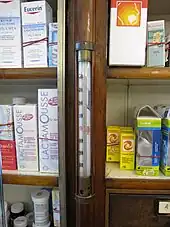

The Réaumur scale (French pronunciation: [ʁeomy(ː)ʁ]; °Ré, °Re, °r), also known as the "octogesimal division",[1] is a temperature scale for which the melting and boiling points of water are defined as 0 and 80 degrees respectively. The scale is named for René Antoine Ferchault de Réaumur, who first proposed a similar scale in 1730.[2]
Change in scale
Réaumur's thermometer contained diluted alcohol (ethanol) and was constructed on the principle of using 0° for the melting temperature of water, and graduating the tube into degrees, each of which was one-thousandth of the volume contained by the bulb and tube up to the zero mark. He suggested that the concentration of alcohol employed be such that it began boiling at 80 °Ré – that is, when it had expanded in volume by 8%. He chose alcohol instead of mercury because it expands more visibly, but this posed problems: his original thermometers were very bulky, and the low boiling point of alcohol made them unsuitable for many applications. Instrument-makers generally chose different liquids, and then used 80 °Ré to signify the boiling point of water, causing much confusion.
During 1772 Jean-André Deluc studied the several substances then used in thermometers and concluded that mercury thermometers were the best for practical use, on the grounds that among these substances its volume varies the most linearly with the method of mixtures. In detail, if two portions of water of equal masses A, B were mixed, and let the resulting water be C, and if we immerse a thermometer in A, B, C, we obtain lengths . Deluc expected that , and similarly for other ratios of mixtures. He found that thermometers made using mercury allowed the closest fit to his expectation of linearity.[3]
From the late 18th century mercury was used almost without exception.[4] Its range is 0 to 80 degrees.
Use
The Réaumur scale was used widely in Europe, particularly in France, Germany and Russia, and was referenced in the works of Thomas Mann, Dostoyevsky, Flaubert, Joyce, Tolstoy, and Nabokov.[5][6][7][8] For example, at the beginning of Book X of The Brothers Karamazov, the narrator says, "We had eleven degrees of frost", i.e. −11 °Ré, equivalent to −14 °C or 7 °F.[9] By the 1790s, France had chosen the Celsius scale as part of the metric system, rather than the Réaumur measurement,[2] but it was used commonly in some parts of Europe until at least the mid-19th century,[10] and in parts of Russia until the early 20th. While living in Paris, George Orwell mentions "translating Réaumur into Fahrenheit" even in 1929. Its main modern uses are in some Italian and Swiss factories for measuring milk temperature during cheese production,[11] and in the Netherlands for measuring temperature when cooking sugar syrup for desserts and sweets.
Uses outside of Europe include a Mexican colonel in Santa Anna's army in San Antonio, Texas in 1836 recording the night's temperature as 34 °F and 1 °Ré.[12]
Conversion between different temperature units
| from Réaumur | to Réaumur | |
|---|---|---|
| Celsius | x °Ré ≘ x × 5/4 °C | x °C ≘ x × 4/5 °Ré |
| Fahrenheit | x °Ré ≘ (x × 9/4 + 32) °F | x °F ≘ (x − 32) × 4/9 °Ré |
| Kelvin | x °Ré ≘ (x × 5/4 + 273.15) K | x K ≘ (x − 273.15) × 4/5 °Ré |
| Rankine | x °Ré ≘ (x × 9/4 + 491.67) °R | x °R ≘ (x − 491.67) × 4/9 °Ré |
| For temperature intervals rather than specific temperatures, 1 °Ré = 1.25 °C = 2.25 °F Conversion between temperature scales | ||








Notes and references
- ↑ Division octogesimale in French.
- 1 2 Simons, Paul (17 October 2007). "How Reaumur fell off the temperature scale". The Times. Retrieved 2022-12-14.
- ↑ Chang, Hasok (2007). Inventing temperature : measurement and scientific progress. Oxford. p. 64. ISBN 978-0-19-533738-9. OCLC 457147642.
{{cite book}}: CS1 maint: location missing publisher (link) - ↑ Herbert Dingle. The scientific adventure: essays in the history and philosophy of science. Sir Isaac Pitman and Sons, London, 1952. Page 131.
- ↑ Thomas Mann, The Magic Mountain, p. 93, Random House, Chapter IV on Google Books.
- ↑ Fyodor Dostoyevsky, Crime and Punishment, p. 268 Vintage Books. Part 3, Chapter VI on Project Gutenberg.
- ↑ Leo Tolstoy, Anna Karenina, p. 685, Wordsworth Editions Limited
- ↑ Vladimir Nabokov, The Real Life of Sebastian Knight, p. 1. Penguin Books.
- ↑ The Brothers Karamazov, trans. Pevear and Volokhovsky (Vintage, 1991), p. 515.
- ↑ Draper, John William (1852). Textbook on chemistry. New York: Harper and Brothers. p. 20.
draper, john william.
- ↑ Reaumur thermometer for Parmigiano-Reggiano cheese)
- ↑ Hansen, Todd E. (2003). The Alamo Reader. Stackpole Books. p. 364.